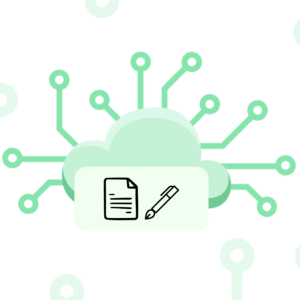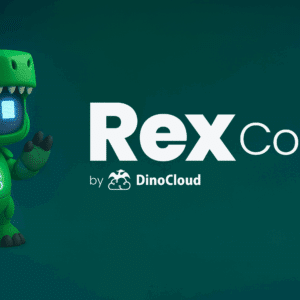
We, at DinoCloud, embrace this spirit. Being a top-tier partner with AWS, we provide cutting-edge, tailor-made solutions. These solutions enhance operational performance and ensure data safety for our clients. The emergence of serverless computing has marked a significant shift in the development and deployment of modern applications.
This guide explores the widespread applications of serverless computing. It details the pros and cons and outlines a user-friendly path to adopting serverless technologies. In the ever-evolving cloud computing world, we’ll examine serverless architecture, function as a service (FaaS), and the array of cloud functions available via AWS Lambda. We’ll also dive into the features of event-driven architecture, microservices, scalability, and how the pay-per-use concept revolutionizes serverless computing.
Key Takeaways
- Serverless computing offers cost savings through a pay-per-use model, eliminating the need for server maintenance.
- Serverless architectures automatically scale to handle fluctuations in traffic, providing seamless scalability.
- Developers can focus on building specific functions without worrying about the underlying infrastructure, simplifying backend coding.
- Serverless computing accelerates the development cycle, enabling quicker feature deployment.
- Potential drawbacks include cold starts, runtime limitations, vendor lock-in, and complex debugging.
What is Serverless Computing?
Serverless computing is a modern approach to backend services. It relies on a pay-as-you-go model. This approach lets users create and run code without handling the infrastructure.
Developers can easily access backend services. They pay only for what they use. This means they avoid paying for idle servers.
Event-Driven Execution
Serverless architectures work on an event-driven basis. Resources are only used when an event triggers code. This method efficiently manages computing resources.
Automatic Scaling
Serverless computing automatically adjusts resources to meet demand. The provider takes care of scaling up or down, handling traffic changes. This removes the need for manual efforts to adjust resources.
Granular Billing
One of the benefits of serverless computing is its detailed billing model. Users pay only for what they use. This can result in substantial cost reductions for organizations.
Short-Lived and Stateless Functions
Serverless functions are designed to be quick and without a lasting state. They promote modularity and easy scaling. Developers can update or deploy these functions independently.
Third-Party Service Integration
It integrates smoothly with many third-party services. Developers are free to focus on their core applications. They don’t need to worry about the infrastructure of these additional services.
Reduced Administrative Overhead
Serverless computing reduces the server management load. Developers can concentrate on improving their applications. This shifts the focus to providing better business value.
Backend Services in Serverless Computing
Serverless computing offers a wide array of backend services. These include databases, storage, and Function-as-a-Service (FaaS) like Cloudflare Workers. With FaaS, developers can execute small sections of code at the edge of the network. This approach leads to a more modular design and makes scaling code easier, freeing developers from maintaining the backend.
Function-as-a-Service (FaaS)
FaaS is integral in serverless setups, enabling the execution of small, independent functions. It does this in response to particular events or triggers. This method obviates the need to oversee server infrastructure, streamlining backend development. Developers can concentrate on coding these functions. This is opposed to the management of entire applications. AWS Lambda are example of FaaS. They provide an economical and flexible solution for running backend operations.
Databases and Storage
In serverless computing, database and storage services are available. They do away with the manual setup and expansion of database hardware. Serverless databases, like Amazon DynamoDB,, follow a pay-as-you-go approach. This allows for simple scaling of storage and compute resources. Serverless storage options, such as AWS S3, also offer benefits. These include scalability, reliability, and a pocket-friendly way to manage data. Such services ensure developers can concentrate on app development. They do so without the hassle of maintaining database or storage infrastructures.
Serverless vs Other Cloud Models
Serverless computing is akin to Backend-as-a-Service (BaaS), Platform-as-a-Service (PaaS), and Infrastructure-as-a-Service (IaaS). However, each variety boasts unique offerings that distinguish it from the rest.
Backend-as-a-Service (BaaS)
BaaS simplifies backend tasks like data storage, freeing up developers to concentrate on front-end endeavors. Yet, its functionality might lack in the event-driven and edge-computing aspects, which are robust in serverless compute environments.
Platform-as-a-Service (PaaS)
PaaS serves as an extensive platform for both app development and deployment. Despite its broad utility, scaling can sometimes be less smooth, and it tends to face startup delays in comparison to the agility of serverless setups.
Infrastructure-as-a-Service (IaaS)
In the IaaS realm, cloud providers handle the bulk of infrastructure management for their clients. This paradigm sometimes includes serverless features, potentially causing confusion by weaving aspects of both models together.
| Cloud Model | Key Characteristics | Advantages | Disadvantages |
|---|---|---|---|
| Serverless Computing |
|
|
|
| Backend-as-a-Service (BaaS) |
|
|
|
| Platform-as-a-Service (PaaS) |
|
|
|
| Infrastructure-as-a-Service (IaaS) |
|
|
|
Advantages of Serverless Computing
Serverless Computing is a game-changer in app development, with cost savings and effortless scalability among its top benefits. With this model, you only pay for what you use, which helps cut expenses. The provider manages scaling automatically, freeing up developers to focus on code. This approach simplifies the backend, boosting development speed and making feature deployment faster.
The pay-as-you-go setup in serverless computing greatly impacts organizations. They get to cut fixed costs, which is a win for their cash flow. Plus, it can often be more budget-friendly than traditional cloud hosting, as costs are tied directly to active server use. This leads to significant savings over time.
Next, the ease of scalability in serverless computing is a major win. The system automatically feeds more resources when needed, such as during spikes in user activity. This dynamic scaling means developers can concentrate on app creation. They don’t need to spend time managing or planning for future server requirements.
Serverless computing also simplifies coding, particularly for the backend. Working with modular functions, developers can set up and run code without dealing with infrastructure. This modular framework makes the code easier to scale and maintain, which streamlines the development process.
Last but not least, the speed at which new features can be added is a clear advantage. Quick deployment means products hit the market sooner, giving companies an edge. This rapid response to market needs is crucial for staying competitive and satisfying customer demands.
Disadvantages of Serverless Computing
Serverless computing brings significant benefits, yet it has drawbacks. It can encounter cold starts that lead to latency issues. Also, runtime limitations pose challenges for certain programming languages and executing time-consuming tasks. Moreover, vendor lock-in and complex debugging are problems due to serverless applications’ distributed nature.
Cold Starts
Serverless computing’s “cold starts” bring widely varying processing times. Code deployment on different server specs causes this. For time-sensitive applications, these latency spikes can be a major issue.
Limited Runtime
Serverless platforms have runtime restrictions. This makes using some programming languages or completing long tasks a challenge. Applications needing intensive processing or consistent states face significant obstacles.
Vendor Lock-In
Moving between serverless providers is hard due to unique configurations. This vendor lock-in makes platform switching complex. It limits organizational flexibility and increases reliance on a single provider.
Complex Debugging
Testing and debugging serverless applications is complex. Replicating production environments is hard, and backend process visibility is often limited. This complexity increases development and maintenance costs.
Benefits of Serverless Computing
In modern application development, Serverless Computing stands out. It brings cost savings by charging only for what you use. Effortless scalability is handled by the provider. With simplified backend coding and modular functions, developers enjoy faster development cycles and quicker feature deployment.
Cost Savings
Organizations can save money with serverless computing. They pay only for the resources they use instead of pre-buying capacity. This cost-effective approach is great for workloads that change. It cuts out over-provisioning, which increases efficiency and cuts costs.
Effortless Scalability
Serverless computing offers automatic scaling. Applications can easily handle changes in traffic and demand. Developers are free to innovate without the worry of scaling infrastructure. Plus, pay-per-use billing means you can scale as needed.
Simplified Backend Coding
In a serverless setup, developers can mainly focus on the front-end development. The backend is taken care of by the serverless provider. This approach makes the coding process simple. It helps teams deploy new features quickly. Built-in service integrations also make development smoother.
Speedier Development
The nature of serverless computing allows teams to work more quickly. They can try out new ideas, update features, and meet customer needs fast. All this happens without the usual infrastructure management. As a result, products get to market faster, and companies can adapt to changes swiftly.
| Serverless Computing Benefits | Description |
|---|---|
| Cost Savings | Pay-per-use model and automatic scaling eliminate over-provisioning, leading to significant cost savings. |
| Effortless Scalability | Serverless platforms handle scaling automatically, allowing developers to focus on building features. |
| Simplified Backend Coding | Serverless computing enables developers to concentrate on front-end development, with backend functions managed by the provider. |
| Speedier Development | The scalability and reduced administrative overhead of serverless computing accelerate the development and deployment of new features. |
Use Cases for Serverless Architecture
Serverless architecture stands out by serving diverse needs efficiently. It’s found in web and mobile application development, real-time data stream processing, and more. This method changes how companies view their tech setup.
Web and Mobile Backends
Building serverless APIs is straightforward and cost-efficient. They adapt well to usage spikes, perfect for web and mobile app backends. This approach skips the initial burdens of setting up complex infrastructures.
Stream Processing
Triggered by messages or logs, serverless processing handles real-time tasks without managing clusters. It’s a top choice for image recognition and rich media apps, saving time and money. The method behind this is straightforward yet powerful.
ETL Pipelines
Serverless architecture suits scalable data processing pipelines perfectly. These pipelines handle data extraction, transformation, and loading hassle-free. The result is agile and efficient data processing without the usual upkeep load.
Event Processing
For event-based actions like security checks, serverless functions are unmatched. They optimize workflows like automated testing and website deployments. This speeds up development and operation activities, benefitting delivery speed and scalability.
Cron Jobs
Scheduling tasks via serverless methods means no worries about dedicated servers. It fits well for tasks not on schedule, adjusting server use automatically. Demand-based scaling avoids over-provisioning and keeps resources efficient.
Microservices
In the realm of microservices, serverless concepts thrive. They allow for independent, easily scalable, and maintainable small services. This model boosts flexibility, quickens deployment, and enhances system robustness.
Serverless adoption grows as its flexibility shines in various scenarios. Organizations worldwide benefit from its adaptable nature. Our experts at DinoCloud excel in navigating this serverless path, empowering businesses with cloud-native solutions. This guidance is pivotal for those aiming to maximize the benefits of serverless and fuel their digital progress.
Conclusion
Serverless computing faces certain hurdles, but its pros outweigh the cons. It saves money, scales easily, simplifies coding in the backend, and speeds up development. However, it’s crucial to see if it’s right for a particular use. DinoCloud leads the way in advising businesses on their serverless path. They ensure a smooth start and offer strategic advice.
Our expert team is eager to aid companies in making the most of serverless computing. By embracing serverless adoption, businesses improve their use of resources. They cut down on costs and can put more focus on being innovative and enhancing customer experiences.
The serverless computing community is vibrant and filled with useful services. This aids in creating applications packed with features. DinoCloud knows the cloud and all about serverless technologies. This makes us a reliable partner for those wanting to smoothly transition to this powerful computing model.
FAQ
What is Serverless Computing?
Serverless computing transcends traditional backend models by operating on-demand. It frees users from managing infrastructure. Developers seamlessly access backend services, only paying for what they use.
What are the key characteristics of Serverless Computing?
Serverless computing boasts distinctive event-driven execution and automatic scaling. It offers granular billing for efficiencies. Its functions are agile and ephemeral, designed to integrate third-party services easily.
What Backend Services are available in Serverless Computing?
Its services span databases and storage, plus Function-as-a-Service capabilities. For instance, Cloudflare Workers facilitate deployment at the network edge. This promotes modularity and scalability in applications.
How does Serverless Computing differ from other Cloud Computing models?
While similar to BaaS, PaaS, and IaaS, serverless computing’s unique selling point lies in its event-driven and usage-based model. BaaS supports storage, PaaS eases app development, and IaaS involves managing customer infrastructure, sometimes with serverless options.
What are the advantages of Serverless Computing?
Serverless Computing brings notable benefits. These include cost savings from pay-as-you-go pricing, automatic scaling for growth, and modular architecture for simplified development. It significantly accelerates feature deployment.



